Most charges were down, but sex harassment, LGBT charges were up.
On Wednesday, the Equal Employment Opportunity Commission released its charge-filing statistics for fiscal year 2018, which ran from October 1, 2017, through September 30, 2018.
According to Law360, EEOC charges in FY 2018 were at their lowest level since 2006. Yes, 2006. When George W. Bush was President of the United States. Before the Americans with Disabilities Act was amended. Long before #MeToo. The year that my 31-year-old graduated from high school. *sniffle*
All of which is wonderful news for employers, but the news wasn’t completely good. Sexual harassment charges increased by 13.6 percent compared with FY 2017, and the monetary relief obtained by the EEOC in sexual harassment charges increased by more than 20 percent. I have a theory about that and a prediction, which I’ll save until the end of this post.
There was also an increase in the relatively low number of LGBT discrimination charges filed (a subset of sex discrimination), and an increase in the monetary relief obtained.
All of the EEOC’s statistics, dating back to 1998, are available here.
The big picture
Nationwide, the EEOC received 76,418 charges, and resolved 90,558 charges (the latter figure would include charges from prior fiscal years). The agency obtained $505 million for victims and reduced its “workload” (should that be “backlog”?) by 19.5 percent.
The agency filed 199 lawsuits, 117 of which alleged individual instances of discrimination, 45 of which alleged discriminatory policies, and 37 of which alleged systemic discrimination.
In years past, retaliation has been the most common charge, followed by race, with sex and disability (post-ADA amendments) not far behind. This year, retaliation stayed in the lead, but race charges declined significantly, dropping into fourth place. That put sex discrimination charges (all types, including sexual harassment and LGBT discrimination) in second place, and ADA charges third. But the numbers for sex, disability, and race were very close.
The numbers for the other types of charges were about what we’ve come to expect over the years. The “Big Four” were followed by age, national origin, color, religion, and Equal Pay Act, in that order. Genetic discrimination charges brought up the rear, with a mere 220 charges filed nationwide.
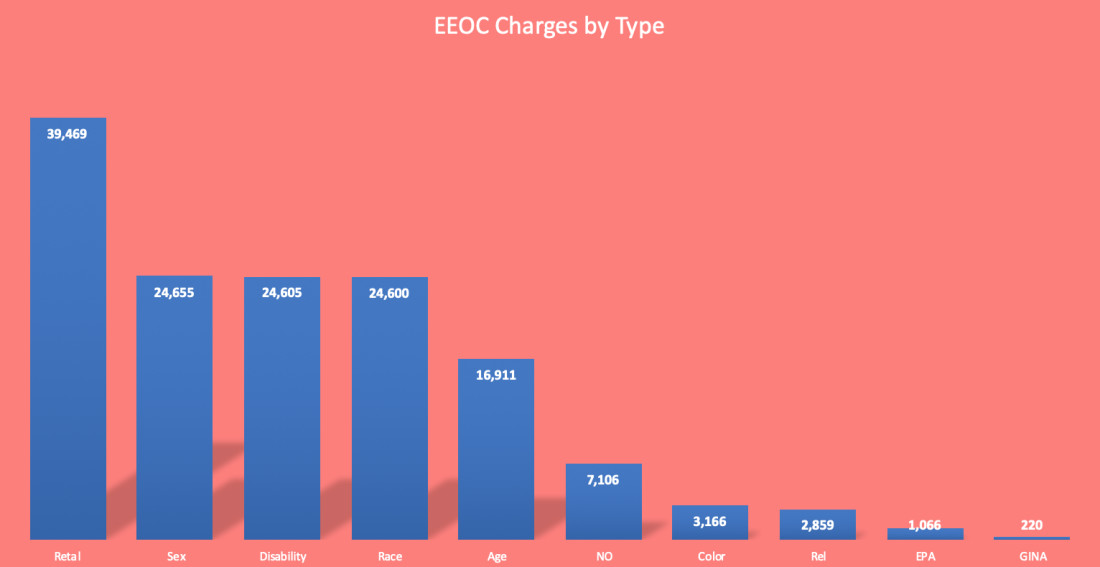 All charges, FY 2018.
All charges, FY 2018.
The Big Four
With the exception of sexual harassment and LGBT charges, the number of charges declined in FY 2018. The following charts show the number of charges in the top categories for FY 2015, 2016, 2017, and 2018. Here is retaliation:
 Retaliation charges, 2015-2018.
Retaliation charges, 2015-2018.
And here is sex discrimination (all types):
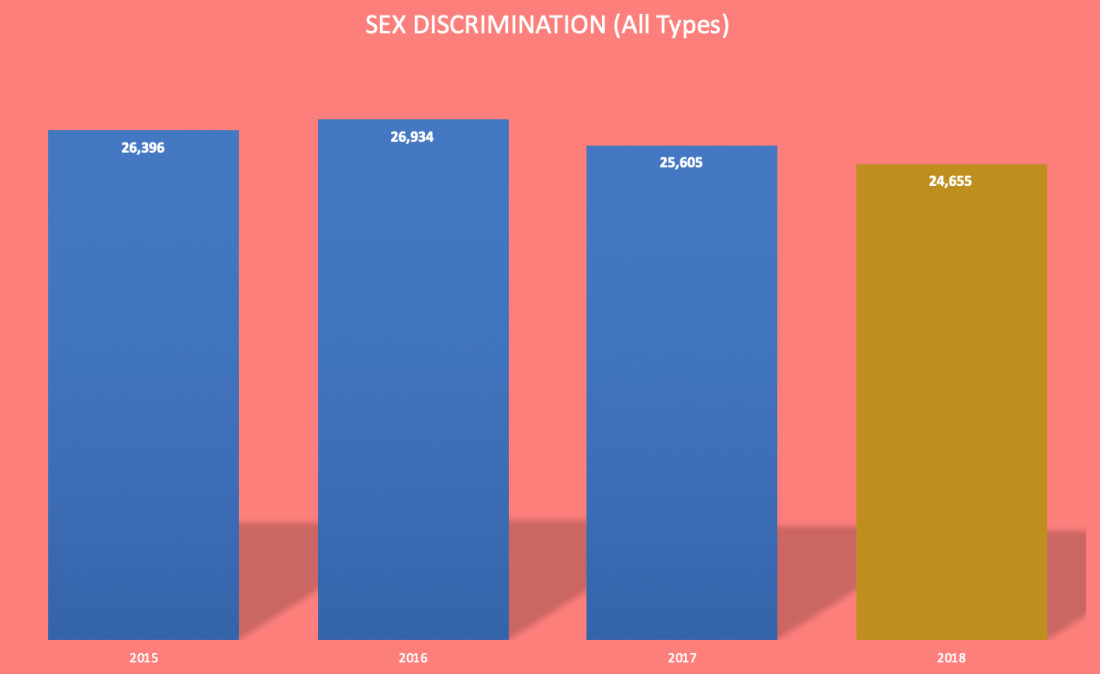 Sex discrimination (all types), 2015-2018.
Sex discrimination (all types), 2015-2018.
Disability discrimination charges also declined. Are employers getting better at fielding reasonable accommodation requests, now that they’ve had several years with the amended ADA? Maybe so.
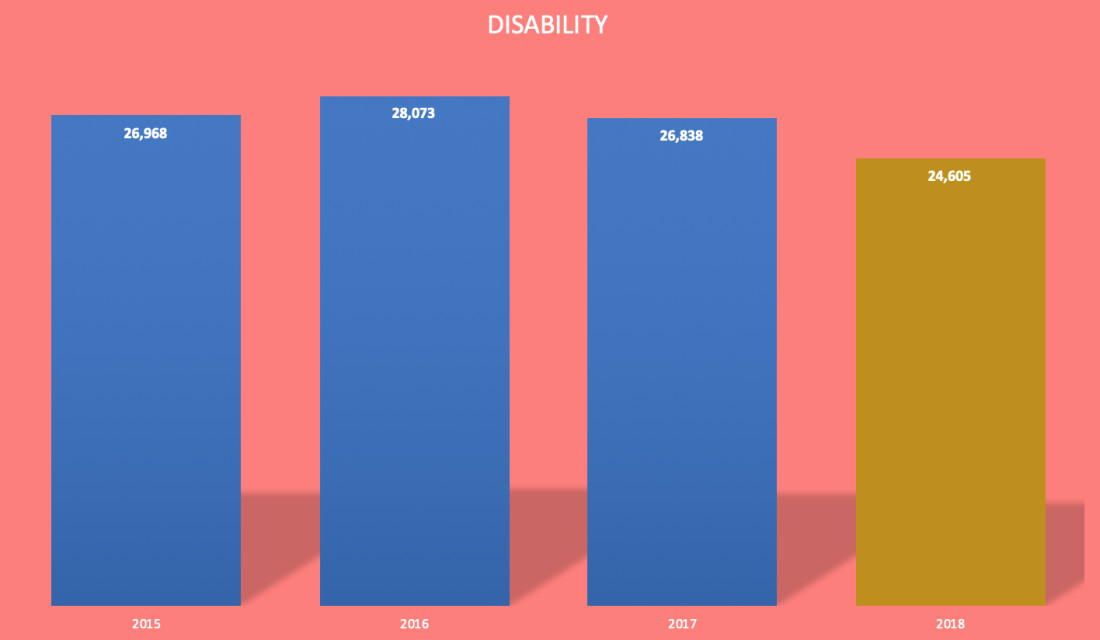 Disability/ADA, 2015-2018.
Disability/ADA, 2015-2018.
And look at the big drop in race discrimination charges. Does anyone have a theory as to why this would be the case? I don’t.
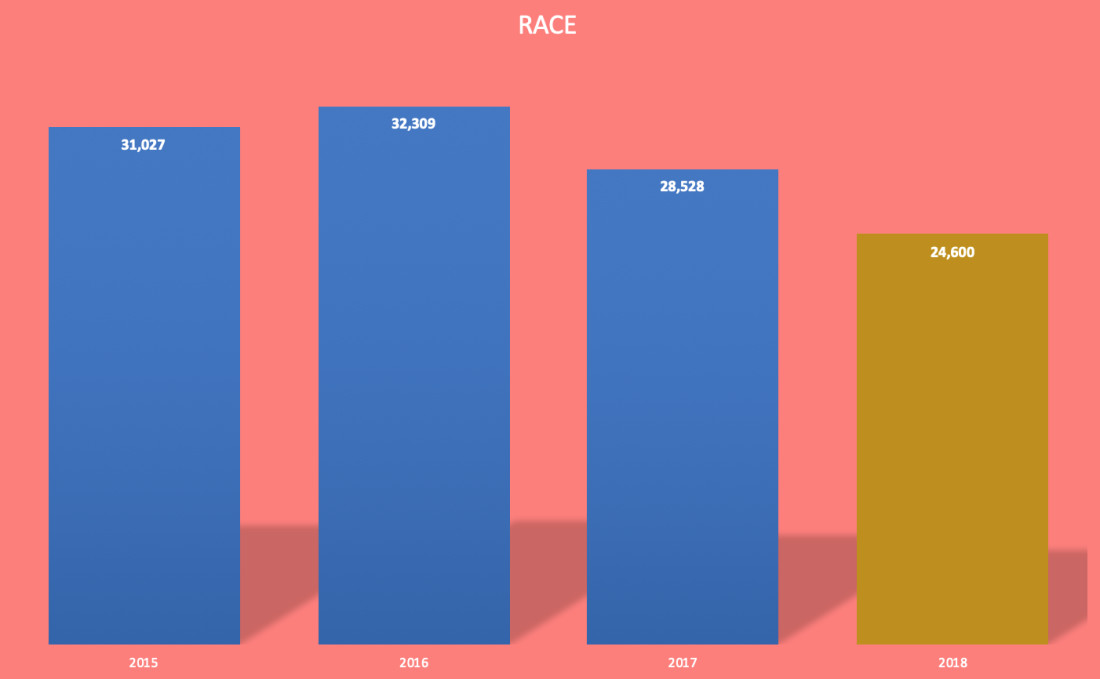 Race, 2015-2018.
Race, 2015-2018.
LGBT
The EEOC, as it must, treats LGBT discrimination as a subset of sex discrimination, so the LGBT numbers are included with “all” sex discrimination charges. However, since 2013, the EEOC has also been tracking LGBT charges separately.
LGBT charges did increase in FY 2018, but they are a relative drop in the bucket — only 1,811 of more than 24,000 sex discrimination charges.
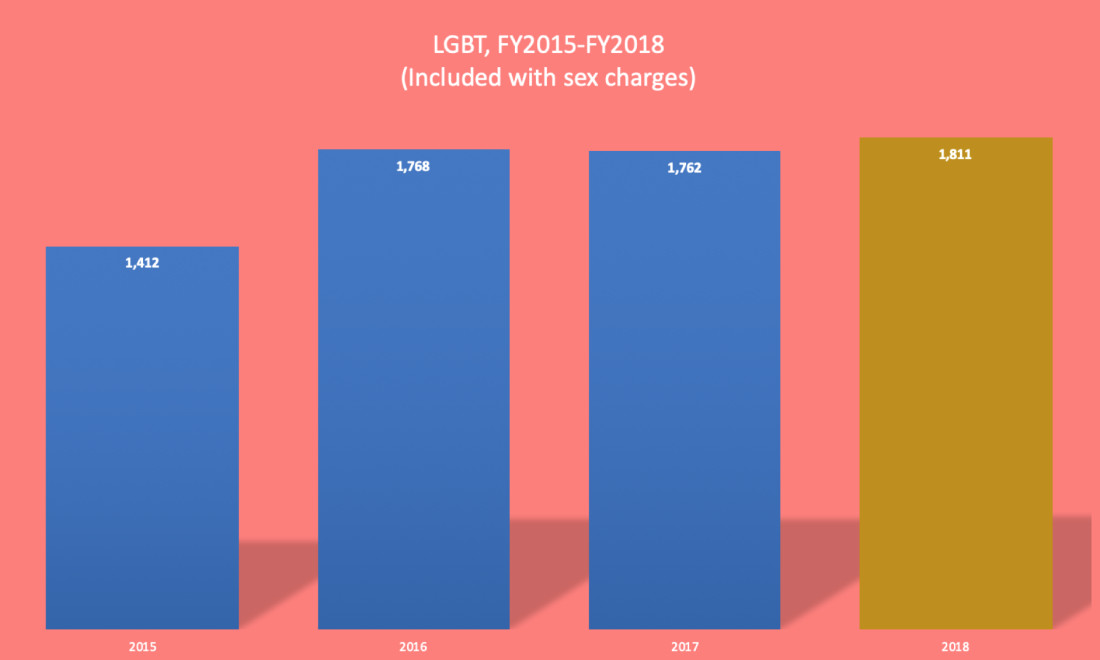 LGBT charges, 2015-2018.
LGBT charges, 2015-2018.
The monetary relief obtained in LGBT cases also increased in FY 2018:
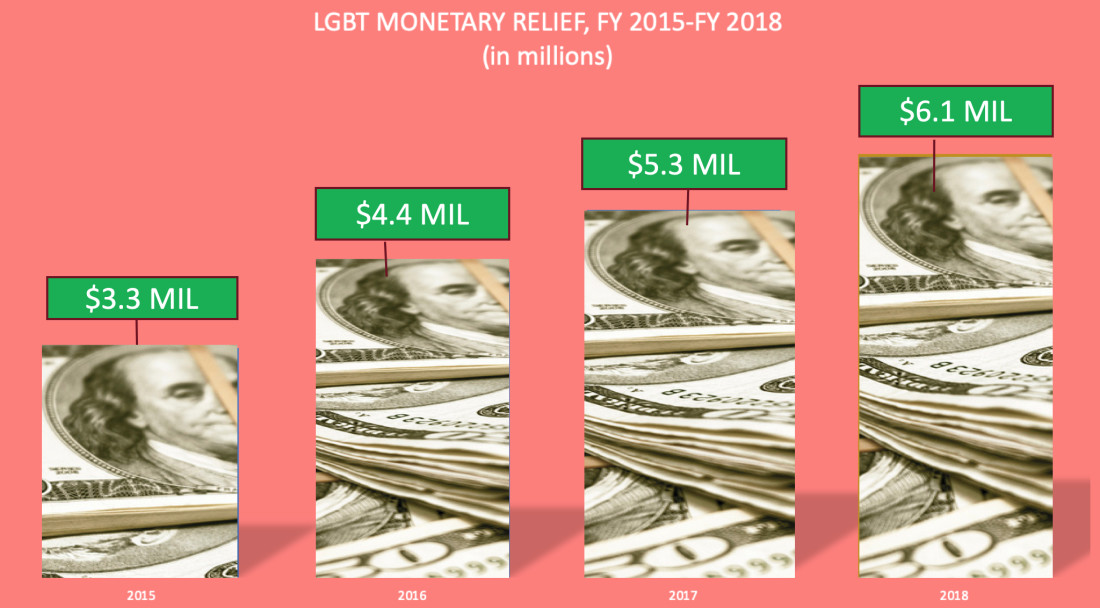 LGBT monetary relief, 2015-2018.
LGBT monetary relief, 2015-2018.
Sexual harassment
On to sexual harassment! Last summer, the EEOC reported a slight “uptick” in sexual harassment charges. But by the fall, the EEOC estimated that it had seen about a 12 to 13 percent increase in sexual harassment charges as compared with FY 2017. The official figure is 13.6 percent, which is pretty close to the fall 2018 estimate:
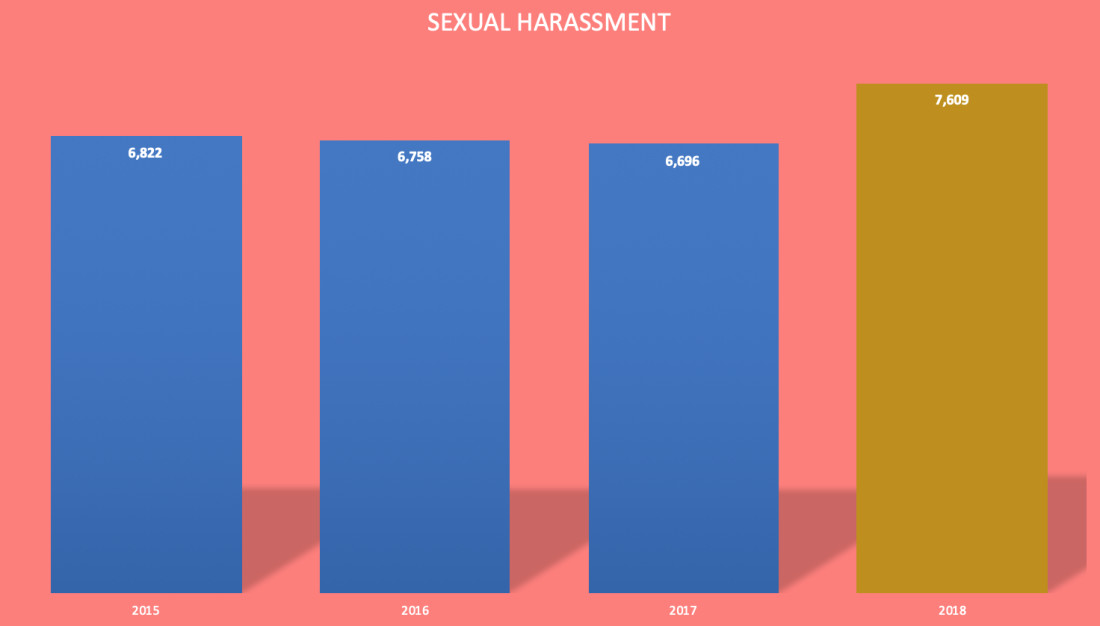 Sexual harassment charges, 2015-2018.
Sexual harassment charges, 2015-2018.
And the monetary relief obtained by the EEOC in sexual harassment cases increased dramatically, by more than 20 percent:
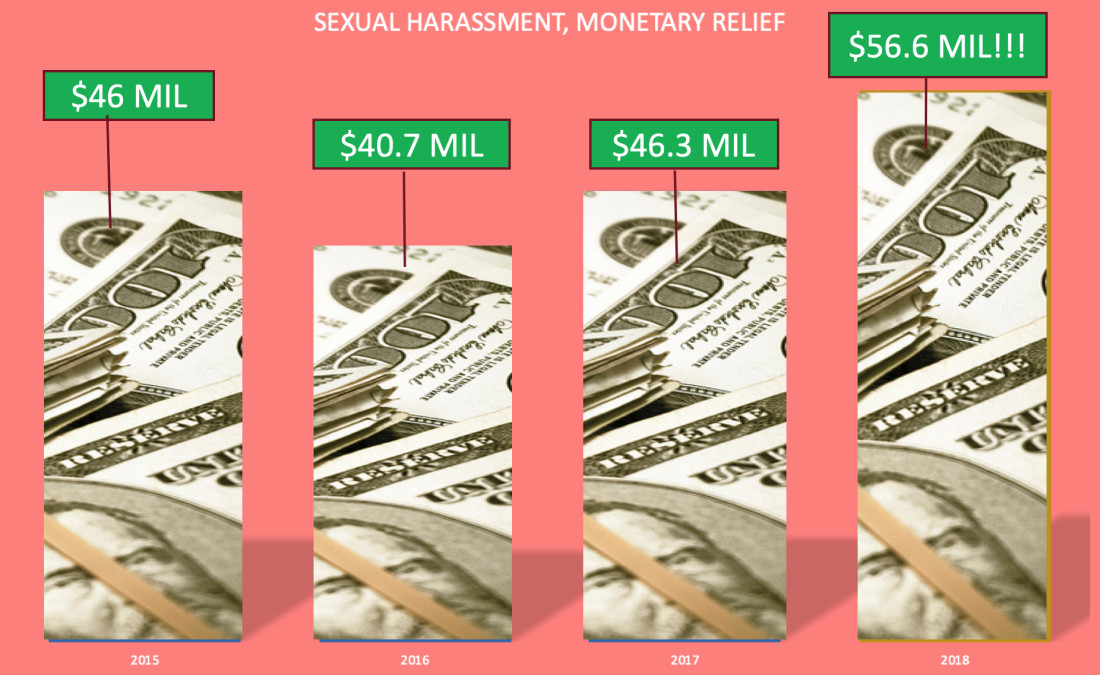 Yikes!
Yikes!
So, in FY 2018, sexual harassment was where the action was. But I am not sure that trend will continue. If you recall, the EEOC saw a slight decline in sexual harassment charges in FY 2017, presumably because the fiscal year ended right before #MeToo became hot.
My theory is that #MeToo may have already peaked. A Gallup poll conducted in February 2019indicated that a significant number of men and a smaller, but still significant, number of women were less likely to believe that sexual harassment in the workplace was a major problem, as compared with respondents who were polled in 2017.
Although the monetary relief obtained by the EEOC in sexual harassment cases was significant, I suspect that in FY 2018 many employers were scared to death of facing a sexual harassment charge or lawsuit, so they were receptive to settling those cases. I’m not sure we’d see that level of employer fear now. Here are a few reasons for my doubt:
Joe Biden: Thus far, apparently no one, male or female (no Democrat, anyway), is particularly concerned about his alleged “handsy” behavior.
Justin Fairfax: The Virginia Lieutenant Governor seems to be hanging in there.
Brett Kavanaugh: He persisted, and now he’s on the U.S. Supreme Court. Meanwhile, Michael Avenatti, who promoted some of the most outlandish allegations against Justice Kavanaugh, is facing a 36-count indictment (although not related to the Kavanaugh hearings).
Here is my prediction: I think the number of sexual harassment charges in FY 2019 will decline slightly. It won’t decline a lot because FY 2019 started on October 1, 2018, and I suspect that we didn’t reach “peak #MeToo” until a little later. I also predict that the monetary relief obtained by the EEOC in sexual harassment cases will decline because employers will be more skeptical of sexual harassment claims and less anxious about finding a quick exit.
Heck, while I’m at it, I’ll go all the way out to FY 2020. In FY 2020, I think we will have returned to pre-2018 levels, both with the number of sexual harassment charges filed and the monetary relief obtained.
Be sure to check back in 2020 so you can make fun of me for being wrong!
Robin Shea is a Partner with the law firm of Constangy, Brooks, Smith & Prophete, LLP and has more than 20 years’ experience in employment litigation, including Title VII and the Age Discrimination in Employment Act, the Americans with Disabilities Act (including the Amendments Act), the Genetic Information Non-Discrimination Act, the Equal Pay Act, and the Family and Medical Leave Act; and class and collective actions under the Fair Labor Standards Act and state wage-hour laws; defense of audits by the Office of Federal Contract Compliance Programs; and labor relations. She conducts training for human resources professionals, management, and employees on a wide variety of topics.

